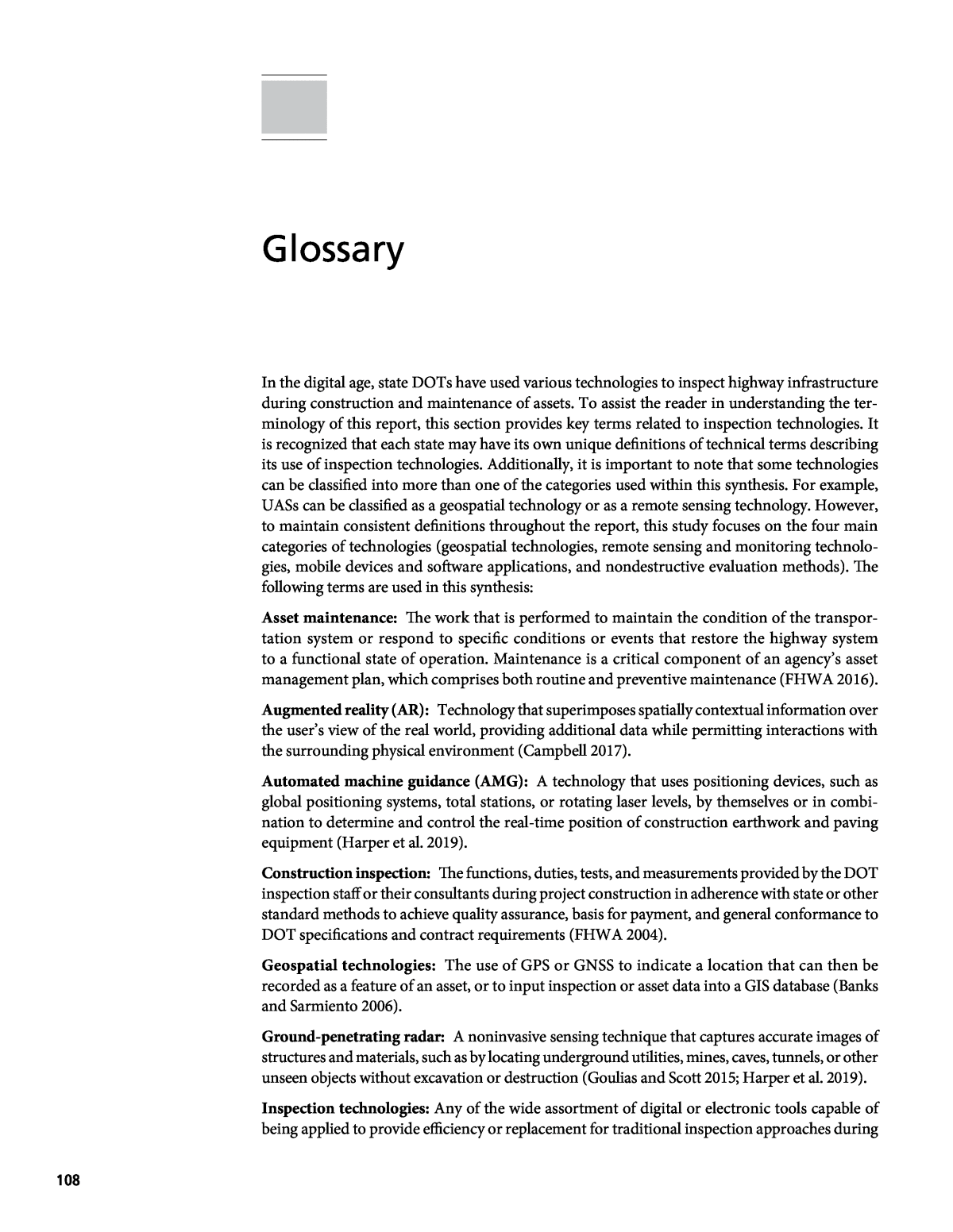

Below is the uncorrected machine-read text of this chapter, intended to provide our own search engines and external engines with highly rich, chapter-representative searchable text of each book. Because it is UNCORRECTED material, please consider the following text as a useful but insufficient proxy for the authoritative book pages.
108 Glossary In the digital age, state DOTs have used various technologies to inspect highway infrastructure during construction and maintenance of assets. To assist the reader in understanding the ter- minology of this report, this section provides key terms related to inspection technologies. It is recognized that each state may have its own unique definitions of technical terms describing its use of inspection technologies. Additionally, it is important to note that some technologies can be classified into more than one of the categories used within this synthesis. For example, UASs can be classified as a geospatial technology or as a remote sensing technology. However, to maintain consistent definitions throughout the report, this study focuses on the four main categories of technologies (geospatial technologies, remote sensing and monitoring technolo- gies, mobile devices and software applications, and nondestructive evaluation methods). The following terms are used in this synthesis: Asset maintenance: The work that is performed to maintain the condition of the transpor- tation system or respond to specific conditions or events that restore the highway system to a functional state of operation. Maintenance is a critical component of an agencyâs asset management plan, which comprises both routine and preventive maintenance (FHWA 2016). Augmented reality (AR): Technology that superimposes spatially contextual information over the userâs view of the real world, providing additional data while permitting interactions with the surrounding physical environment (Campbell 2017). Automated machine guidance (AMG): A technology that uses positioning devices, such as global positioning systems, total stations, or rotating laser levels, by themselves or in combi- nation to determine and control the real-time position of construction earthwork and paving equipment (Harper et al. 2019). Construction inspection: The functions, duties, tests, and measurements provided by the DOT inspection staff or their consultants during project construction in adherence with state or other standard methods to achieve quality assurance, basis for payment, and general conformance to DOT specifications and contract requirements (FHWA 2004). Geospatial technologies: The use of GPS or GNSS to indicate a location that can then be recorded as a feature of an asset, or to input inspection or asset data into a GIS database (Banks and Sarmiento 2006). Ground-penetrating radar: A noninvasive sensing technique that captures accurate images of structures and materials, such as by locating underground utilities, mines, caves, tunnels, or other unseen objects without excavation or destruction (Goulias and Scott 2015; Harper et al. 2019). Inspection technologies: Any of the wide assortment of digital or electronic tools capable of being applied to provide efficiency or replacement for traditional inspection approaches during
Glossary 109  construction or in the evaluation of assets to determine condition, location, characteristics, dimensions, features, or other data collection needs (Maier et al. 2017). Light imaging, Detection, and Ranging (LiDAR): An active optical remote sensing system used for measuring the distance between a surface and its sensing units through laser light pulses to create accurate 3D models of any surface within visual sight of the sensing unit (Mallella et al. 2018). Mobile devices and software applications: A software package designed to function on a mobile device such as a smartphone or tablet, typically with a specific or customized purpose. Some state DOTs have mobile applications customized to serve their inspection staff (e.g., appli- cations for sign inventories). Mobile applications typically transfer data to larger enterprise or GIS systems (Dadi et al. 2016). Nondestructive evaluation methods: A means of analyzing and assessing the condition of various structural components of in-service highway infrastructure assets (e.g., pavement, bridges, and tunnels) without impairing their future usefulness (FHWA 2021b). Remote sensing and monitoring technologies: The use of technologies and sensors to provide inspection or monitoring at a physical distance from the point of assessment. Remote sensing can include a range of technologies and sensors (e.g., accelerometers, remote cameras, or traffic loops) that are configured to operate remotely and provide data access via radio, cellular networks, the internet, or other communication means (Mallela et al. 2018). Unmanned aircraft systems (UASs): An aircraft and its associated elements, which operate with no human pilot on board. The elements of a UAS include the unmanned aircraft vehicle, a ground-based controller, and a communication system between the aircraft and the controller. UASs can be equipped with various components such as cameras and sensors to collect specific data (Austin 2010). Virtual reality (VR): A computer-simulated environment in which a user can interact in a realistic or physical way within that environment, using an interactive 3D model that allows that person to manipulate the model to test the effects of changes before making them in the real world (Campbell 2017).
